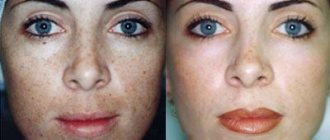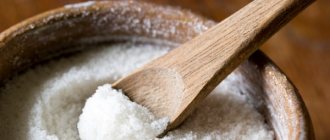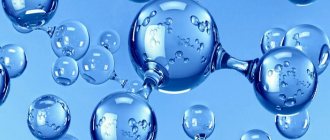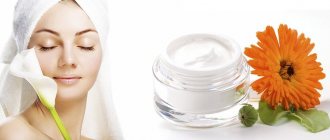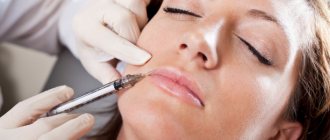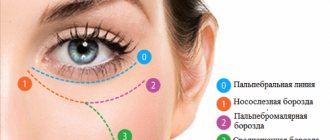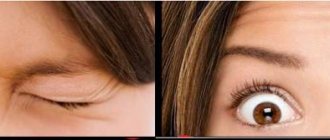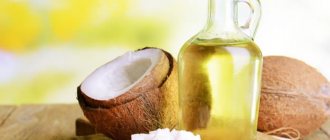What is hyaluronic acid
The substance hyaluronate, or hyaluronic acid, is a natural polysaccharide that is naturally produced in the human body. The main purpose of the substance is to bind and retain water molecules, in other words, to maintain water balance in cells. In addition, hyaluronate takes part in the process of cell restoration and the formation of capillaries, promotes the synthesis of collagen and elastin.
Until the age of 25, the substance is produced in sufficient quantities by the body itself. However, then its production decreases, and the so-called “age-related changes” of the skin begin. The first wrinkles and deep folds appear, the shape of the lips changes, and the oval of the face loses its clarity. In such cases, additional intake of hyaluronate in the form of injections, tablets or powders is recommended.
Indications for the use of hyaluronic acid for the face
It is recommended to start taking the substance not just like that, but if there are appropriate indications. They are:
- noticeable aging of the skin and the appearance of wrinkles;
- signs of disturbance of the water balance of the epidermis;
- joint diseases and inflammatory processes associated, among other things, with impaired fluid metabolism;
- eye diseases.
If the listed ailments or age-related skin changes are not observed, there is no reason to resort to hyaluronate. If there is an excess of a substance in the body, its properties can cause harm rather than benefit.
Methods of using hyaluronic acid
The beneficial properties of hyaluronate can be applied in several ways. In medicine and cosmetology, injections and preparations for external and internal use based on the substance are used.
Injections (shots) with hyaluronic acid for the face
The introduction of a substance into the body through injections is most popular. This is the most convenient way to get quick results - the beneficial properties of hyaluronate penetrate deeply and almost instantly into the tissue.
It is customary to distinguish several injection options for different epidermal problems.
- Biorevitalization is a procedure that uses a chemical cocktail with a high content of hyaluronic acid to smooth out deep wrinkles. It is advisable to use the method after 40 years, when skin aging becomes truly pronounced. The benefits of hyaluronic acid injections appear instantly - the result is noticeable after the first session.
- Mesotherapy is a simple procedure based on the introduction of a smaller amount of active substance under the skin of the face. Recommended for use between the ages of 25-30, a pronounced effect appears after 3 procedures.
- Fillers are a spot correction procedure using acid, the effect appears instantly. The method is recommended for use in case of local problems with the beauty and health of the skin - to correct the shape of the lips or tighten the oval of the face.
The results of beneficial injections last quite a long time - throughout the year.
Lip augmentation with hyaluronic acid
A common way to use hyaluronic acid is through injections into the lip contour area. With age, lips begin to lose shape, become thinner and fade. The benefit of hyaluronic acid in the lips is that the beneficial substance fills the tissues and attracts water, therefore increasing their volume, giving the lips a bright color and making them plump and smooth.
The achieved result lasts up to 18 months, the final effect of the procedure appears on the second day.
Attention! The harm and benefits of hyaluronic acid injections directly depend on the volume and how much the lips increase.
When carrying out the procedure, care must be taken not to disturb the natural proportions of the face and not to harm yourself.
Hyaluronic acid preparations
The beneficial properties of hyaluronate are used not only to improve appearance, but also to improve health, since the substance is a natural component of synovial fluid and takes part in the functioning of many body systems. In pharmacies you can find several of the most common drugs based on the substance.
- HyaluromCS is a solution for the treatment of joints based on hyaluronic acid and chondroitin sulfate, sold in injection form.
- Viscosil is a solution which, in addition to acid, contains sodium chloride, dihydrogen phosphate and hydrogen phosphate. It is also used by injection and is intended to relieve pain and swelling in the joints.
The tablet form is represented by many products, among which the useful drugs KWC, DoppelHerz, Laura and Solgar are especially well known. Hyaluronic powder is also available for purchase - it is used to create masks.
Hyaluronic acid in facial cosmetics
Not everyone needs hyaluronate injections, but the properties of the substance still remain beneficial even for young skin. Therefore, the benefits of hyaluronic acid in creams and masks are often used. In small volumes, the properties of the substance do not have such a pronounced effect, but still have a positive effect on the condition of the skin and do not cause harm.
Creams, lotions and masks with hyaluronic acid soften the skin, normalize the water balance in its cells and even out the complexion. The color of the epidermis improves, the first wrinkles disappear. Useful cosmetics are recommended for use even by women under 30 years of age, given the low concentration of the substance, there will be no harm from its properties.
Hyaluronic injections
Hyaluronic acid injections can be called one of the safest that beauty salons offer in the fight for youthful skin. With its help, you can tighten the oval of your face without resorting to surgical interventions with a knife.
Nasolabial and eyebrow folds, facial wrinkles, scars, a blurred chin, weak cheekbones - all this is the sphere of action of acid. With its use, it is possible not only to eliminate age-related changes, but also to correct congenital defects.
Since acid is produced by the body, the synthetic material is much more pleasant for the body than, for example, Botox. Experts themselves claim that injections with this substance provoke the natural production of hyaluronic acid. Moreover, the natural protective and regenerative functions of the skin begin to activate.
Acid injections are considered absolutely safe and hypoallergenic. The injection is made using a very thin needle into areas that require correction. The rejuvenation effect is noticeable immediately after the procedure, the duration of which rarely exceeds half an hour. After administration, the drug must be distributed, this takes some time, but only after this can the result be assessed at 100%.
The only disadvantage of artificially introducing hyaluronic acid is that after some time it simply disintegrates and leaves the body. Consequently, the achieved effect disappears. Therefore, to maintain a constant “tone” you will have to regularly visit a cosmetologist to repeat the procedures.
Instructions for use of hyaluronic acid
Hyaluronic acid is sold in several forms - tablets, ampoules and powders. Methods of application and dosage vary, so you need to know in what quantities and under what conditions the drugs can be used.
In tablets
For joint diseases and to improve skin condition, hyaluronic acid in capsules and tablets is beneficial. Take 1 tablet three times a day with food, washing down with water; there is no need to chew the drug. The nutritional supplement is taken in a course - the intake should last at least a month.
Important! When using hyaluronic acid tablets, it is extremely important to drink at least 2 liters of water per day.
This condition cannot be neglected; the benefits and harms of hyaluronic acid in tablets depend on it, because the properties of the substance lie precisely in the binding of water molecules in tissue cells.
In ampoules
Injections of beneficial hyaluronic acid are carried out for both medical and cosmetic purposes, and in the latter case, the dosage should be no more than 30 mg for a separate area of the skin. Since the substance in injections has a quick and strong effect, injections must be carried out under the supervision of a cosmetologist. Self-administration of the substance for injections under the skin of the face is categorically not recommended - if the procedure is carried out incorrectly, it will only cause harm.
If hyaluronic acid preparations are used to treat joints, then you must follow the instructions for the specific product or doctor’s prescriptions. If self-medicated, injections may be useless or even harmful.
Powder
In addition to tablets and ampoules, you can find hyaluronic powder in pharmacies. It is usually used to prepare a solution for facial skin - dilute a pinch of powder in 30 ml of water and leave for half an hour to an hour until the product swells. After this, the mixture is mixed to eliminate lumps and distributed over clean skin, and a mask or cream is applied on top.
Contraindications and possible harm
With dosed and reasonable consumption of dietary supplements and products containing lauric acid, it cannot cause harm to health. The only contraindication is individual intolerance.
If you eat more coconut oil than normal, you should reduce the amount of carbohydrates in your diet. As for pregnant women and nursing mothers, they are not recommended to overuse coconut and other oils rich in lauric acid. Since its effect on the body is not fully understood.
Masks with hyaluronic acid at home
If there are no indications for useful injections yet, but you want to restore skin tone and slightly rejuvenate your face, you can make masks at home. There are several of the most effective recipes suitable for different skin types.
Alginant mask with hyaluronic acid
The following remedy will help tighten the skin and smooth out fine wrinkles:
- 7 g of sodium alginate are diluted in 70 ml of clean water and left for 5 hours;
- then add 12 g of kelp powder to the water and pour in 20 ml of cold green tea;
- after this, add 15 g of hyaluronic powder and mix thoroughly.
The mixture must be spread over the skin in a layer 5 mm thick, and it must be kept for a quarter of an hour.
Mask with honey and hyaluronic acid
To improve facial tone and slightly rejuvenate the skin, you can use a honey mixture. They do it like this:
- 11 drops of hyaluronic acid are mixed with 12 g of honey;
- add 15 g of natural yogurt and 17 g of chickpea flour;
- diluted with water and spread over the skin with a wide cosmetic brush.
You need to keep the useful composition for half an hour, and it is recommended to wash it off with a herbal decoction, for example, from plantain.
Moisturizing mask with hyaluronic acid
The following product will help restore water balance and improve skin elasticity:
- fresh cucumber is peeled and crushed into pulp;
- add 12 g of yellow clay and 14 drops of hyaluronic acid;
- mix and spread over the skin for half an hour.
After use, you can additionally apply moisturizer to your face.
Mask with collagen and hyaluronic acid
To improve the condition of thin, dry skin and smooth out wrinkles, you can make the following mixture:
- Pour collagen powder over warm green tea and stir for several minutes until it is completely dissolved;
- add 10 drops of hyaluronic acid and 5 drops of retinol, stir, apply to the face in several layers.
When applying the mixture, movements must be made from top to bottom. Keep it for half an hour, and then carefully remove the frozen film. It is better to use the product regularly, and after 35 years - in courses of 15 procedures.
Mask with glycerin and hyaluronic acid
A product with glycerin will help nourish the skin with vitamins, relieve irritation and moisturize the epidermis:
- A fresh apple is baked, the pulp is extracted and mixed with 5 g of orange zest.
- Add 15 drops of hyaluronic acid and 3 ml of glycerin and mix.
- The skin is cleansed with a natural scrub, and then the mask is carefully applied to the face.
You need to keep the product for about 40 minutes, then you will need to moisturize your facial skin with a nourishing cream.
How to take monolaurin?
The instructions for using monolaurin are quite simple: capsules should be taken 2-3 times a day with meals, washed down with a sufficient amount of clean water (200-300 milliliters). It is not recommended to drink the drug with carbonated water or any warm liquid (otherwise the capsule may collapse earlier than expected). Between doses, you need to maintain as much equal time as possible. Regularity is very important: if you take the drug for about a week and then forget it for several days, the effectiveness will be many times lower. Instructions for using monolaurin for children and adults are no different.
The maximum daily dosage of monolaurin for adults is 3000 milligrams. Children should definitely check the dosage of monolaurin with a doctor; giving a dietary supplement to a child without prior consultation is highly not recommended. The minimum age at which children can start taking monolaurin is 3 years.
Important! Pay attention to the date of manufacture of the drug; its shelf life is 2 years if storage conditions are observed. Taking the supplement after the expiration date is prohibited.
How to take monolaurin for herpes?
Monolaurin has one of the strongest effects on the herpes virus. It cannot be considered a complete medicine, but it helps speed up the relief of symptoms and skin restoration if used simultaneously with antiviral medications.
If you want to prevent the appearance of herpes, then it is enough to take about 1000 mg of monolaurin per day - that’s 2 capsules per day. If you already feel symptoms that foreshadow the occurrence of a rash, then in the first few days you can take an increased dose - 1500–2500 mg.
How to take monolaurin at the first sign of a cold?
It is advisable to start taking monolaurin even before the first symptoms appear: as soon as the cold and flu season begins. This will strengthen the immune system and prepare it for any troubles, cleansing the body of viruses and bacteria. In this case, 2 capsules of 500 mg per day are enough.
If you have not been involved in prevention and already feel that you are starting to get sick, then monolaurin will still be very useful. For several days, increase the daily dosage to 1500–2500 mg. If the condition improves, the dose can be reduced and the course continued for prevention. If the disease takes over, then you can continue the course with an increased dosage (the main thing is not to exceed the limit of 3000 mg per day). When using medications, it is better to reduce the dose of monolaurin to 1000 mg.
How to take lysine and monolaurin together?
One of the dietary supplements with which monolaurin is often combined is lysine. Lysine is an essential amino acid that also improves immunity and strengthens the body, and is also involved in the biosynthesis of muscle protein. Taking lysine and monolaurin creates a synergistic effect, increasing the effectiveness of both dietary supplements.
When taken together, monolaurin must be consumed in the same amount and according to the same rules. Lysine is taken from 2 to 6 times a day. The daily dosage should not exceed 3000 milligrams
, the optimal dosage is calculated based on personal weight and other parameters:
- 40–60 mg/kg for children;
- 30–45 mg/kg for adults;
- 55–80 mg/kg for athletes;
- 60–75 mg/kg for vegetarians.
Use of hyaluronic acid in medicine
The substance is actively used in medicine. It serves as an effective and safe restorative and lubricating agent - this allows it to be used in several areas at once.
For joints
Synovial fluid, which acts as a lubricant for joints, normally contains hyaluronic acid. In case of joint diseases, the concentration of this substance decreases several times.
Therefore, to treat ailments, the benefits of hyaluronic acid for joints are used and the practice of injecting hyaluronate directly into the joint cavity is used - this helps relieve inflammation and eliminate pain. Patients return to normal motor activity, and with regular use of hyaluronic acid and other medications, it is even possible to restore tissue structure.
For wound healing
The benefits of hyaluronic acid for the skin are used in the treatment of burns, wounds and trophic ulcers. As a rule, a special dressing material is coated with the substance and bandages are used until healing. A useful remedy is also used in surgery - it helps to quickly restore tissue after operations.
For eyes
The restorative and moisturizing properties of hyaluronate are used in the treatment of eye diseases. The substance is part of eye drops for dry corneas; the acid is also used in eye microsurgery to create optimal conditions for surgery and protect tissue from accidental damage.
Harm of hyaluronic acid
A useful substance, if used carelessly, can cause harm:
- If you use the substance for too long, then its natural production in the body will noticeably decrease, therefore, the effect of the properties of hyaluronic acid will have to be constantly maintained artificially.
- If there is insufficient fluid intake into the body, dehydration may occur.
- If the skin is poorly moisturized after masks with hyaluronic acid and injections, increased dryness may be observed.
Advice! Taking the substance must be combined with plenty of drinking - at least 2 liters per day, otherwise the properties will be harmful.
Side effects of hyaluronic acid
When used carefully, the properties of the substance rarely cause side effects. However, if there are contraindications or incorrect dosages, harm is still possible. It is usually expressed in swelling of the tissues, redness on the skin and the appearance of hematomas on the face - the latter more often occur in smokers.
The listed side effects disappear within a few days, but there are also more serious consequences. For example, if injections are carried out carelessly, fibrosis may occur - thickening of the skin at the injection site. In rare cases, scars or granulomas may form.
To avoid side effects, after beneficial injections you should:
- avoid direct sunlight and do not go to the solarium;
- refuse physical activity;
- do not visit baths, saunas and swimming pools;
- do not take too hot a bath or shower;
- do not use decorative cosmetics and scrubs.
You need to follow these recommendations for about 3 days. After the expiration of the period, the deep and superficial layers of the epidermis will return to normal, and you will be able to enjoy the effect of hyaluronic acid without giving up your usual activities and procedures.
What is lauric acid
Lauric (dodecanoic) belongs to the category of carboxylic acids. In its pure form it is a white powder with a subtle and not very pleasant oily odor, which evaporates when heated.
The melting point of the crystals is 440 C, the boiling point is about three hundred degrees Celsius.
It is a “saturated fat,” a medium-chain triglyceride that is more easily absorbed by the body than long-chain triglycerides. The chemical structure is simple. Thanks to this, the body digests and absorbs lauric acid in a similar way to carbohydrates. The empirical formula is C12H24O2, molar mass is 200.31 g/mol.
Contraindications to the use of hyaluronic acid
The benefits and harms of hyaluronic acid when taken orally or through injections depend on the presence of contraindications. To ensure that the beneficial properties of a substance do not cause harm, you need to know when not to use it. Hyaluronic acid is prohibited when:
- diabetes mellitus;
- oncology;
- blood diseases;
- ulcers and gastritis - do not take tablets with this substance;
- dermatological rashes;
- allergies.
Hyaluronic acid is also not recommended for pregnant women; its properties should not be used during lactation, during colds, or during infectious diseases. You cannot carry out beneficial injections immediately after deep peeling, photorejuvenation procedures or laser resurfacing - you need to wait at least a month.
Features of skin care after the procedure
Despite the fact that this procedure is not a surgical operation, proper skin care after biorevitalization with hyaluronic acid will avoid complications.
Therefore, for two days after the procedure, you should treat the skin with an antiseptic cream. During the recovery period, it is not recommended to use decorative cosmetics, as well as new creams or lotions for the skin.
The use of hyaluronic acid can significantly improve the appearance of the skin, eliminate acne and early signs of aging. However, the positive effect of the procedure will only occur if you use high-quality products from a professional cosmetologist. Self- administration of drug injections can only cause harm and serious side effects.
